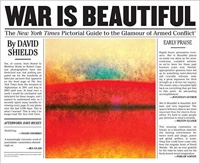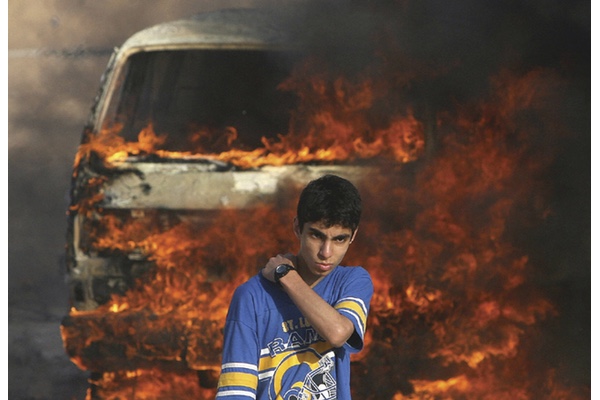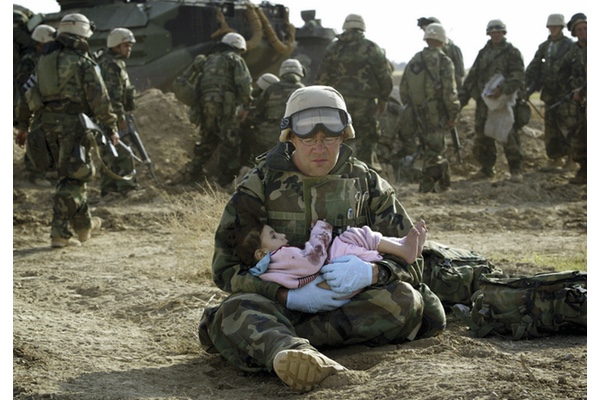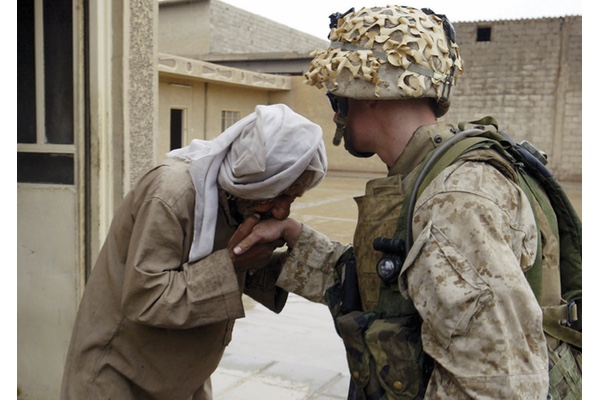Does Even the New York Times Glamorize Modern Armed Conflict?

Professor David Shields (Photo by Tom Collicott)
As many commentators have observed, the George W. Bush administration could not have successfully manipulated the misinformation that led to the invasion of Iraq in 2003—and ensuing disasters—without the complicity of the mainstream media.
At the annual White House Correspondents Dinner on April 29, 2006, comedian Stephen Colbert mocked this media complicity with power in a withering satirical monologue in which he saw reporters as mere “stenographers” for the administration:
The president makes decisions; he’s the decider. The press secretary announces those decisions, and you people of the press type those decisions down. Make, announce, type. Put them through a spell check and go home. Get to know your family again. Make love to your wife. Write that novel you got kicking around in your head. You know, the one about the intrepid Washington reporter with the courage to stand up to the administration. You know–fiction.
News coverage of U.S. wars in Iraq and Afghanistan has suffered under military restrictions with embedding of reporters and policies that prevent certain photographs and stories as editors in the mainstream media censor images and accounts that reveal the human cost of modern war to shield the public and promote military adventurism.
 Bestselling
author David Shields argues in his new book, War
is Beautiful: The New York Times Pictorial Guide to the Glamour of
Armed Conflict
(Power House Books), that even
the “Paper of Record,” The
New York Times,
has been complicit with power by sharing unquestioning accounts of
war and offering visual images that hide the true horror and human
consequences of war. Instead of the graphic and often shocking photos
that depicted the reality of the bloody conflict in Vietnam,
Professor Shields contends that the
Times
has presented our twenty-first century wars at a distance, with
little visual documentation of how modern armed violence cruelly
damages real people.
Bestselling
author David Shields argues in his new book, War
is Beautiful: The New York Times Pictorial Guide to the Glamour of
Armed Conflict
(Power House Books), that even
the “Paper of Record,” The
New York Times,
has been complicit with power by sharing unquestioning accounts of
war and offering visual images that hide the true horror and human
consequences of war. Instead of the graphic and often shocking photos
that depicted the reality of the bloody conflict in Vietnam,
Professor Shields contends that the
Times
has presented our twenty-first century wars at a distance, with
little visual documentation of how modern armed violence cruelly
damages real people.
The book grew out of Professor Shields’ concern about how he became “enchanted and infuriated” by the paper’s compelling front-page war photos. To better understand how the Times portrayed war, he analyzed thousands of front-page photographs, and particularly full-color photos since 2001 of the wars in Afghanistan and Iraq.
As a result of his research, Professor Shields found that the war photos that run in the “Paper of Record” help to advance catastrophic U.S. military endeavors by featuring beautiful, heroic, aesthetically-pleasing images from the combat zone. War is Beautiful includes 64 striking, full-color images from the Times that are well composed and visually striking but, as Professor Shields asserts, are also akin to “recruiting posters” that filter reality rather than document the true horror of our recent conflicts and attest to the Times abandonment of its role as part of the Fourth Estate: to speak truth to power.
Readers have praised War is Beautiful for its original thought, moral imagination, extensive research, and stunning presentation. Author Lawrence Wechsler referred to the book as “a powerful and important work of visual poetry.” And celebrated novelist Frederick Barthelme commented that Professor Shields “has the best ideas about what a book is or might be, what its function is, how it might fit into the culture. Almost alone among writers these days he’s an adventurer, putting together volumes that surprise and challenge and threaten us and deliver remarkable insights, intriguing new views of the world. Now he comes with a wonderful book of photographs and quotations—and a truly disruptive purpose. He has put together a dangerous and contemplative book that forces us to see behind the curtain at two great American institutions, government and journalism, wrapped in distressing embrace.”
Professor Shields teaches in the English Department at the University of Washington, Seattle. He is the author of author of nineteen other books, including Reality Hunger (named one of the best books of 2010 by more than thirty publications); The Thing About Life Is That One Day You’ll Be Dead (New York Times bestseller); and Black Planet (finalist for the National Book Critics Circle Award). His work has also appeared in the New York Times Magazine, Harper’s, Salon, Slate, and McSweeney’s, among others, and he is the recipient of Guggenheim and NEA fellowships.
Professor Shields graciously responded to questions about his new book by telephone from his office in Seattle.
Robin Lindley: How did you come to write War is Beautiful? Did it grow out of your past work as a literary collagist?
David Shields: It is connected to previous books of mine and previous collage gestures. In a way it goes back to a 2001 book I wrote or collaged called Baseball is Just Baseball: The Understated Ichiro. I found about 120 quotes from Ichiro and put them in an order to make a statement about Ichiro’s relation to American culture and to Eastern and Buddhist thought. That book was not authorized by the Mariners or Ichiro—although I think he liked the book. That book was my first to gesture toward re-purposing of quotations, appropriation, remixing, montage, and all of that.
Probably the book that most connects to collaging and remixing is Reality Hunger: A Manifesto, which came out in 2010. That book lays down some tracks about rethinking the laws of appropriation and how we think about genre, and suggesting ways that art can move forward in the twenty-first century. And I’ve done some other work that has played with appropriation.
That brings us to War is Beautiful. I’ve been a reader of the Times since my early teens. With the first Gulf War and the wars in Iraq and Afghanistan, I was startled, stymied, mystified, and riveted by these front-page war photographs that were too beautiful by half. They’re in color, since the Times started running color photos on page A1 in October 1997.
I wondered, was it just me and my over-reading of these images? Was it the Times oddly championing the war? What’s going on here? So I had UW research assistants help me pull nine thousand front pages from the Times from microfilm and microfiche going from 1991 through 2013. I wanted to test my hypothesis: were there categories of gestures such as war as fashion shoot; war as movie trailer; war as modern masterpiece painting. For every category, we found dozens of photographs that fell into those categories.
I was hoping for a course correction. And no writer necessarily thinks it’s a brilliant career move to publish a book-length critique of The New York Times. I was hoping for more pictures that were more naked, raw and grisly, but I found precious few such examples. Of one thousand combat photos I found on page A1, seven hundred of them met my definition of glamorizing, aestheticizing, anesthetizing photographs. The other three hundred just seemed blandly neutral.
I gathered the pictures and got it down to the key 64 images in the book. The publisherbought licensing rights from photo licensing agencies. I gathered the quotations for the chapter headings and wrote the intro. Dave Hickey, the art critic, wrote the afterword. And voila, there’s this very strangeand controversial—or at least conversation-generating—book.

Palestinian boy and burning vehicle ("Movie") Mohammed Abed/Agence France-Presse-Getty Images
Robin Lindley: You mention a compulsion to see the Times front-page photos each day.
David Shields: I wanted to look at my addiction to “war porn.” The book is multilayered and problematically beautiful. The pictures are beautiful and I was drawn to them.
The book is a critique of the Times, but it’s also a critique of me and the rest of us who are seduced by these images. This is how we, like lambs, are led to slaughter. For me, it took too long to sever the connection between me and my cache of these gorgeous images. I was never totally seduced by them, but they were ungodly beautiful and I wanted to study my own nerve endings, and I was assisted by thousands of these images.
There’s a tradition of aestheticizing battle that goes all the way back to Homer, from the ancientGreeks all the way to war movies. Somehow the Times seemed particularly egregious in this matter because the Times monetizesits brand as the Commissar of the Real, the Fourth estate, the paper of record, the first draft of history. They have this odd role in American culture of capital “T” Truth or, if it’s in the Times, it somehow happened.
There’s a very problematic message with the deification of war going on in these pictures, which pretend to be blandly neutral or quasi-reportorial but, in a way, are a sort of cheerleading and a kind of propaganda in support of the war being worth the sacrifice, and not the sacrifice of upper-class readers of The New York Times, but the sacrifice of other people’s children, other people’s sons and daughters.
There are very serious combat photographers from Matthew Brady during the Civil War, Edward Steichen in World War II, and many New York Timesphotographers during the Vietnam War. But a whole series of sea changes since Vietnam have pushed the Times’ war photography into a more glamorizing mode. One of those reasons is that we have an all volunteer army and the people who tend to be soldiers are from lower-income families, and are more rural, less educated and more men and women of color—and more typically not readers of The New York Times. The end result is that the Times is more comfortable glamorizing these wars knowing its readers are terribly unlikely to serve in the Afghanistan or Iraq conflicts.
Robin Lindley: You make a case that The New York Times is complicit with power, particularly with the wars in the Middle East. You compare some of the photos you feature to recruiting posters. How is the Times' relationship with power revealed in its history?
David Shields: That’s a complicated argument, but I ask what is the Times doing here, and what is the context of that? A good book about the history of the Times is called The Trust, and I quote the coauthors throughout the book.
The Times was founded in 1851 by a German-Jewish family. Anti-Semitism in the U.S., which was much more virulent than it is now, was visited against The New York Times, and it was accused of being “too Jewish” a newspaper.
There’s a strong argument to be made that the Times during the Holocaust, under this German-Jewish family, deliberately underreported the full extent of the atrocities. Afterward, the Times was properly criticized for underreporting those crimes against humanity.
My argument is that the Times has wildly overcorrected. The Times always wants to be at the dead center of American culture—to be complicit with American power and American government and to be always at the center of the conversation. That’s the Times’ brand.
With only a very few exceptions, the Times has rather aggressively supported every American military misadventure since World War II, to the point of having their editorial columnists like James Reston advising John F. Kennedy and at the same time editorializing in favor of the man who he was advising. This continued with Thomas Friedman who still advises Obama. And there was William Safire who advised Bush and editorialized in favor of Bush and Reagan.
So the point is that the Times underreported the Holocaust and was widely criticized for hugely failing in that coverage. Over the last 70 years, the Times has taken a rather bellicose, American masculine, militaristic posture toward war. It supported the Korean War, to a large extent the Vietnam War, and the Afghanistan and Iraq wars. LBJ said, “I can’t win this war without the support of The New York Times.” Only very late in the Vietnam War did the Times join people like Walter Cronkite and express some skepticism.
That provides a socio-historical contextfor why the Times, founded by German Jews and being the victim of a lot of anti-Semitism from say 1850 to 1950, then overcorrected after World War II, and ever since has made sure it does not stray from a complicit bargain with the powers that be. For example,they’ll bury an article on page 27 that may have a slightly negative information about the war, but that front page, A1 photo, has huge power and sets the entire argument that the war is a sacrifice worth making, that the war is noble and dignified, and in a way a beautiful cultural enterprise.
I don’t know how conscious all of this is, but it seems almost a willful visual gesture that sends an unmistakable message to the powers that be and the culture as a whole that the war is a worthy sacrifice.
Robin Lindley: That’s a powerful statement. Have you heard anything from The New York Times?
David Shields: I have, but much of that is off the record. I doubt the Times will review the book, and I think the Times is not delighted by the book. Stephen Colbert and Jon Stewart deconstructed the reporting about the war by right-wing media like USA Today, Fox News, the Wall Street Journal. Those deconstructionsare easy to do with such propaganda machines.

Soldier cradling infant ("Father") Damir Sagolj/Reuters
Robin Lindley: Stephen Colbert called the press, like Times’ reporter Judith Miller, “stenographers” for Bush and Cheney at a White House gala.
David Shields: That’s a point I try to make in the book. The reporting of [Times’ reporter] John F. Burns was disastrously credulous on the Iraq invasion, and with Judith Miller, he carried water for Bush-Cheney. These pictures are the visual equivalent.
My beef is less with the photographers and far more with the photo editors and page A1 editor. Photographers have told me off-the-record that they’re sending hundreds if not thousands of photos every week to the Times and every other institution. These pictures are criticized often for being “too violent,” of all things. Most people know that war is violent. Or pictures may be seen as “in bad taste.” But, as Picasso said, “the enemy of great art is good taste.” What I try to point out is how ludicrously tasteful these pictures are. It’s as if they’re covering war through a thick film of Vaseline—there’s very little war here.
I think some of the photographers are struck by how predictable it is that their less revelatory pictures and their more blandly compositionally beautiful pictures are the photos that get chosen, rather than the photos that more faithfully document the actual horror of war. It seems the Times is looking for pictures that aestheticize war rather that those that show what war is like.
Robin Lindley: I’ve interviewed some combat photojournalists, such as Michael Kamber, who edited an anthology of Iraq War photos called Photojournalists on War, and Peter van Agtmael on Disco Night 9/11, his book of photos on the Middle East wars abroad and at home. They both noted that photographers were frustrated by censorship at both ends—by the military abroad and by editors at home who seem to want to shield readers from the human reality of modern war.
David Shields: Exactly. I’ve been doing readings of the book around the country, and quite a few veterans and photographers come up to me and express gratitude for the book, and say the idea that these pictures say anything about war is so ludicrous, and it’s important to point out what an absolute horror storm war is. Some of them show me photos on their phones or physical photographs.
General Sherman said, “War is Hell,” and it would be good if these pictures pointed that out. The underlying message of the photos that the Times ran is that war is a very pretty and very distant event. There’s no hell here; just a mild heck. That seems to me worth pointing out because who knows when the next run up to the next war is, and who knows what country the U.S. will invade.
It would be good if we knew by what process we get sold the next war. One of the many ways war gets sold is in prominent magazines and newspapers. The New York Times disseminates a certain image and it really matters—unlike USA Today, the Wall Street Journal, or Fox News—because the Times is understood as being in the center or center-left, and the Times carries important cultural symbolism so it seems an important task to pull out these images from the so-called “Paper of Record” that is sending out unmistakably flag-waving, cheer-leading, pro-war messages through these pictures.
You mentioned censorship. A crucial part of the censorship and self-censorship is the military’s brilliant, Machiavellian move to embed and keep journalists and photojournalists from direct battle and to get the agreement of the media to, for example, not show pictures of caskets coming back from war.
These [policies] have created censorship as well as self-censorship for journalists and photojournalists sending material back home. They don’t have access to stories or situations that are terribly revelatory.

Iraqi man thanking soldier ("God") John Moore/Associated Press
Robin Lindley: It’s a different world than photographers such as David Douglas Duncan, Eddie Adams, Tim Page and Catherine Leroy found during the Vietnam War.
David Shields: Right. Some won Pulitzer Prizes with The New York Times. Many of their photographers were compositionally beautiful but more faithfully documenting war. Eddie Adams photographed a naked girl running through napalm, which is the iconic image of the Vietnam War. And there’s Nick Ut’s picture of the execution-style assassination [of a Viet Cong captive] by a Vietnamese captain.
In 2013, The New York Times ran an article called “The 12 Most Important images of the Vietnam War.” They ran a slide show of the culture defining images of that war. The question is where are these pictures from the Iraq and Afghanistan Wars, and they’re strikingly not in The New York Times.
Robin Lindley: Susie Linfield, a cultural historian, wrote about photography and political violence in her book The Cruel Radiance. She believes that if viewers look beyond a photograph of atrocity, the image can possibly prompt change. She notes that European reformers in the late 1800’s shared photos of African workers whose hands or feet were cut off as punishment by white overseers. She believes that the photos were critical in communicating the plight of the workers and prompting reform. Linfield ponders the role of photography in responding to the painful reality of modern war, and she also tends to disagree with Susan Sontag’s view that photos of violence or atrocity are exploitative and numbing.
David Shields: Yes. I tend to agree more with Linfield. Sontag profoundly misunderstands photography and develops a convenient argument that all photography somehow numbs the viewer. It’s an impossible argument.
Robin Lindley: Are there examples of photos the Times could have run that you think better captures the reality of war?
David Shields: My book attempts to decry how the photos swirl over an aestheticized rapture rather than struggle with the more purposeful, hard-earned beauty.
If I had found a lot of examples in the Times, I wouldn’t have published my book. I have a cache of seven thousand images, and I could have done a book of nothing but images of war as fashion shoot, or war as movie trailer, or war as modern masterpiece, or war as pieta.
An example that comes to mind was not from the Times, but was a series of photos from The New Yorker that was published about a decade ago, which Colin Powell claimed helped him to endorse Obama over McCain in the 2008 election. That series of pictures included an incredible image of an American soldier who had come home from the war wearing his military dress uniform with his bride in her wedding dress—and his face had been almost completely blown off. It’s a graphic and well-composed photograph. It absolutely brings home [that reality]. And that sequence of photographs had the relatively modest effect of Colin Powell endorsing Obama, according to Powell, and that might have helped Obama be elected. So a series of photographs altered a very powerful man’s decision to endorse one less militarily-inclined candidate over another. The world is full of such examples.
Robin Lindley: The Times seemed particularly reluctant to show images of wounded or dead American troops, whereas such images of Iraqis or Afghanis have been run. That reluctance may be an issue in every war. In World War II, Life magazine didn’t show images of dead Americans until 1943, with a photo of dead soldiers on a beach in New Guinea. And more recently, a Seattle photographer was officially reprimanded for photographing flag-draped coffins of American dead from Iraq.
David Shields: It’s a military policy I guess not to allow the media to show caskets coming back from war. And you have the embedding of journalists and photojournalists, and then you get the censorship. And then the Times is working overtime to access the highest levels of government and to deepen its brand as a quasi-Paper of Record.
Adding up all of these things, there’s almost nothing left. There’s no war there. There’s no attempt to document reality. It’s basically the war as screen saver, as wallpaper—a very distant aesthetic experience. Certainly, part of that is not to show the American dead except in a posture of composed relief. It seems the grief is kept out of frame in any true sense of agony or viscera or blood.
Some people criticize media outlets for showing gruesome images, and then there’s the Times at the other end in which there is a highly aestheticized and “dignified” war that is fought. It’s not that I have it all figured out or have found a newspaper or magazine that has embodied a perfect duration of these photographs. Certainly, after the Paris attacks, the BBC website and the Daily Telegraph of the U.K. showed more direct images. A Danish blogger also showed strikingly more revealing images than the Times with its self-periodically and comically glamorizing photos of Paris post-bombing.
In the book, the last few images are of a dead Iraqi soldiers left behind.
I think what’s so insidious is that it's not as if the Times is overtly disseminating the most obvious propaganda by only showing dead soldiers of the enemy. The Times is much more subtle, and that bears mentioning. These pictures are not overt propaganda, as you might have seen in World War II, but I argue they are a not too oblique propaganda with the beautifying, sanctifying photographs.
Robin Lindley: I thought some of the photos you included were gritty and moving. There’s a photo of a body washer preparing the corpse of a dead Iraqi for funeral, and there’s another of a woman and her children walking in a bloodstained hallway. These images seem to say something about the reality of war.
David Shields: I tried to include a range of photographs and some people have pointed out that a few have a certain emotional power. I was trying to produce a useful metaphor that in these pictures war strikes me as beautiful. Some people find in some images, like those you mentioned, that there’s an attempt to convey war’s horror. Reasonable people can disagree.
There are images in the book from a completely abstract sunset or cartridges that completely aestheticize war to, on the other end, pictures that convey a certain element of war. There’s a man carrying a young boy in the chapter on pieta. Even though the picture conveys what looks like a boy dying, it was striking to me that it fit into the Christian image of the fallen Christ from the crucifixion. The other image that you mention shows a woman walking across a bloody floor and she’s holding by the hand one child and holding in her arms another child. That was part of a chapter on beauty with her strikingly beautiful face.
Even though these pictures are more raw and visceral than other pictures in the book, I was trying to point out that both of these pictures—in my view—muffle war: in the first case, through the Christian pieta symbolism and, in the second case, by focusing on the woman’s strikingly beautiful face.
I tried to include a range so that the viewer could see that, even if pictures gesture timidly toward war’s horror, to me the viewers distance themselves through visual tropes that the Times built in. I’m not saying this is all purposeful, but there’s an accidental amnesia that quickly happens with the viewers.
Robin Lindley: Do you believe your book may prompt a change in how the Times and other publications decide on the images of war to carry—photos that capture the human consequences of war?
David Shields: That would be interesting. I saw the book as a long letter to the editor. I don’t read the Times anymore. I had read it for more than 40 years.
I ask that the Times think about the kind of power it has. It’s not what it had 30 or 40 years ago, or even ten years ago, but it has a certain power. So on some level this is an attempt to urge the Times to rethink its role, and to urge other similar newspapers and magazines to rethink their roles. I urge them also to depend less on complicit institutional journalism and more on independent thinkers and journalists and authors who are not beholden to institutional powers.